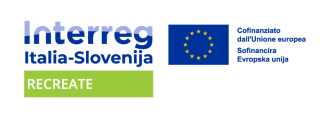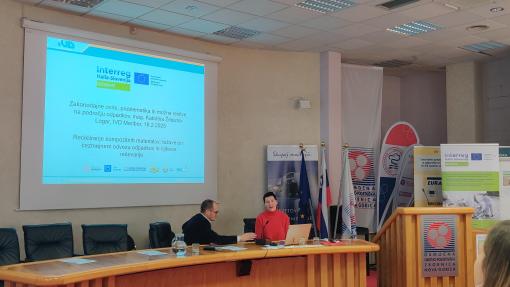On February 18, 2025, at the Regional Chamber of Nova Gorica, the event Recycling of Composite Materials: Obstacles and Solutions for Cross-Border Waste Transport was held as part of the RECREATE project, co-financed by the Interreg VI-A Italy-Slovenia Programme.The event brought together industry experts, institutional representatives, and companies engaged in waste management and the circular economy.
Following a brief project presentation by URES (Matteo Feruglio), the activities of the project partners were introduced:
Municipality of Spinea – Monica Salviato presented the awareness campaign, which included distributing informational flyers in waste bills and launching the initiative "RICREIAMO A SPINEA", featuring educational workshops in schools to encourage the collection and recycling of CFR materials. A mobile collection center operating on select days in March, April, and May 2024, along with school collection points managed in collaboration with Veritas SpA, played a key role in the project. In addition, a technical document was developed to provide operational guidelines allowing other Italian and Slovenian municipalities to acquire and utilize products made from recycled composite materials. The campaign yielded concrete results, with 26.91% of the collected material identified as CFR, totaling 180 kg.
Technol, Portorose S.r.l. – Nevi Baruca shared the company's experience in waste export, detailing the material sampling process, consultations with experts, and the preparation of necessary export documentation. The collaboration with IRSOE to obtain authorization and the waste sampling conducted by Eurofins Laboratory were also discussed.
GEES Recycling S.r.l. – Franco Mioni presented the company's contribution to the RECREATE project. For Technol, GEES developed prototypes of tank caps using recycled sheets, highlighting the need to improve their mechanical performance. In partnership with the Municipality of Spinea, GEES designed a catalog of circular products and organized a workshop with the Brera Academy to develop new designs for sustainable urban furniture. Additionally, street waste bins made from recycled materials were developed. After presenting the first prototype to the Municipality and Veritas SpA, modifications were made to enhance safety and functionality, leading to the creation of an optimized second prototype.
One of the most significant moments of the event was the presentation by Katarina Železnik Logar from the Institute for Safety and Health at Work, Environmental Protection, Fire Safety, who analyzed the regulatory obstacles that limit waste recycling and cross-border shipments beyond Slovenia.The increasing volume of waste, combined with increasingly strict regulations, is making the transboundary management of certain waste categories more complex. European Regulation 1013/2006/EC, along with the Basel Convention, governs international waste transport, imposing stringent criteria to prevent illegal trafficking and ensure environmentally sound treatment. However, differences in national regulations create a fragmented system, making waste trade and recovery more challenging within the circular economy framework.
One of the key issues is the ban on exporting hazardous waste to non-OECD countries, unless they can demonstrate compliance with European environmental standards. Additionally, recent regulatory updates require independent certification and European Commission approval for all waste exports, reducing the risk of fraud and non-compliant shipments. While these measures strengthen oversight, they may also limit treatment options in more efficient or cost-effective foreign facilities.A particularly complex topic concerns waste containing fiber-reinforced composite materials, widely used in the nautical, aerospace, and automotive industries. The lack of a clear classification of these materials in the European Waste Catalogue creates uncertainty for both producers and waste treatment companies. Without specific codes and well-defined criteria, these materials risk being mistakenly mixed with other difficult-to-recycle waste categories, compromising recovery efficiency.
Katarina Železnik Logar emphasized the need for regulatory updates to improve the traceability and recycling of fiberglass-containing waste, preventing them from simply being disposed of in landfills. She highlighted the importance of cooperation among EU member states to harmonize waste management procedures and reduce bureaucratic barriers that hinder recovery. The session concluded with a call for accelerating the adoption of specific criteria for the classification and treatment of special waste, particularly composite materials.
Additionally, there was an opportunity to present the GREET CE project, highlighting its synergies with Interreg RECREATE. Both projects promote circular economy models and environmental sustainability, with GREET CE focusing on green transition across multiple sectors, particularly eco-construction, sustainable energy, regenerative agriculture, and renewable gas use, contributing to environmental impact reduction and fostering innovative solutions for the green economy.
The event concluded with a discussion session and audience Q&A, aiming to address the challenges of composite material recycling and cross-border waste transport, while promoting innovative and sustainable solutions.

